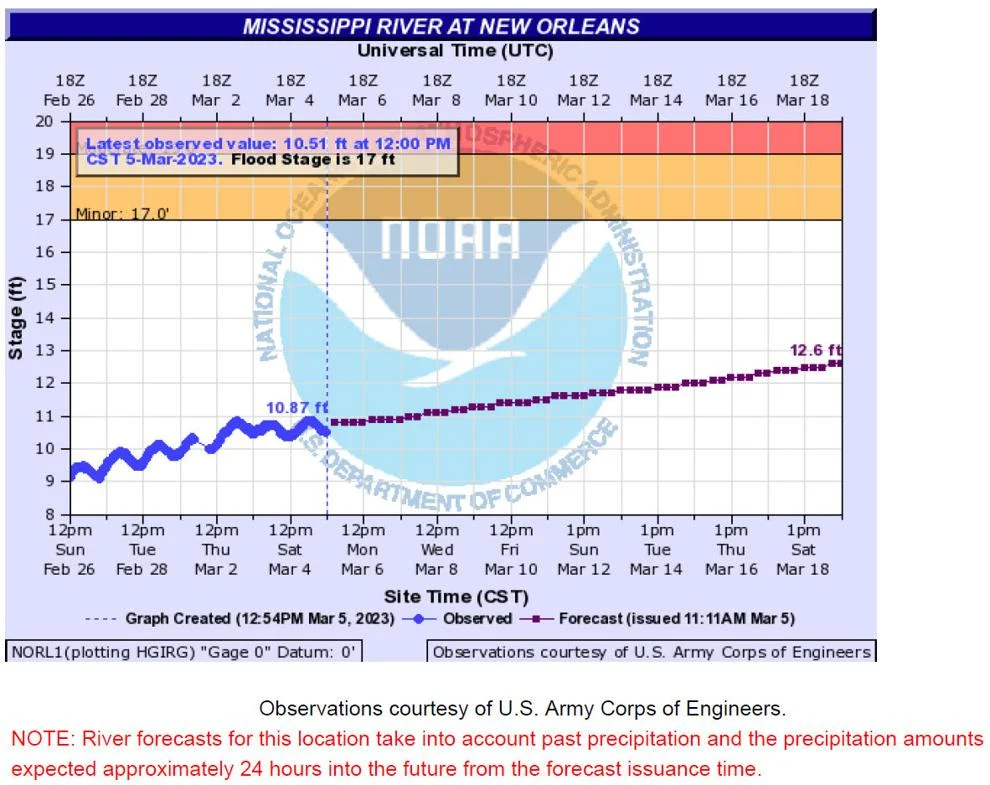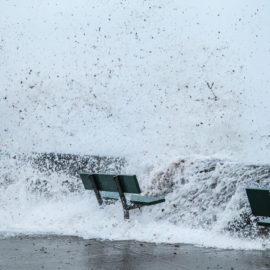
The Mississippi is rising and we are close to Phase 1.
The Army Corps of Engineers is expected to declare a “Phase 1 Flood Fight” as early as Wednesday for the Mississippi River in southern Louisiana, which will trigger prohibitions on construction work within 1,500 feet of river levees and twice weekly inspections by the Corps and local levee districts. The National Weather Service’s Lower Mississippi River Forecast Center, based in Slidell, on Sunday forecast the river to reach 11.1 feet at the Carrollton Gauge in New Orleans, and to continue to rise to 12.7 feet by March 21 before beginning to drop. The gauge is in the water at the shoreline adjacent to New Orleans office of the Corps in the Riverbend neighborhood. Water in river’s main navigation channel is 200 feet deep. The Corps declares its first phase of flood-fighting rules when the water level reaches 11 feet and is forecast to continue rising.
nola.com

Flood stage is 17 feet and we are protected to 25 feet.
Official flood stage at that gauge is 17 feet, but levees and floodwalls in New Orleans now protect to water levels in the river at the gauge of about 25 feet. In a note to emergency managers last week, a forecast center hydrologist said 16-day forecast models showed significant rises on the lower Ohio and Mississippi rivers because of recent frontal passages that will result in crests at minor to moderate flood levels at locations above Baton Rouge through the third week of March. The flood stage at Baton Rouge is 35 feet, and Sunday’s forecast predicted the river would crest there at 34.5 feet on March 19. The Corps work restrictions and increased inspections are precautionary measures. Construction operations can apply to the Corps for a waiver to continue work near the levees. Ricky Boyett, a spokesperson for the Corps, said officials expect the first extra inspection to begin on Monday, March 13.
15 feet triggers the next phase.
If the river were to reach 15 feet at the Carrollton Gauge and be predicted to continue rising, the Corps would move to its second flood-fight phase, which would include a complete ban on work near the levees and daily inspections. Based on the latest forecasts, there will be no need to open the Bonnet Carre Spillway from the river to Lake Pontchartrain to reduce the threat of flooding in New Orleans. The present Corps strategy is to only open the spillway if the river’s flow at the Carrollton Gauge reaches 1.25 million cubic feet per second, which usually occurs when the river reaches about 17 feet at the gauge. Water can leak between the wooden pins in the spillway structure when the river reaches 12 1/2 feet, however, so some water could enter the spillway as early as March 19.

There was a lot of snow and they are sure how that will impact us.
It’s still too early to determine whether this year’s unexpected major snowfalls in the upper Mississippi River basin will have any significant effects on future water levels in Louisiana, forecasters say. That will depend on the rate of melting and the ability of land in the upper basin to absorb the water before it runs off into tributaries and then in the river. The National Weather Service usually issues a spring flood forecast for the entire basin in mid-March.
With all the snow this year I am not surprised the river is up as water flows downhill.



